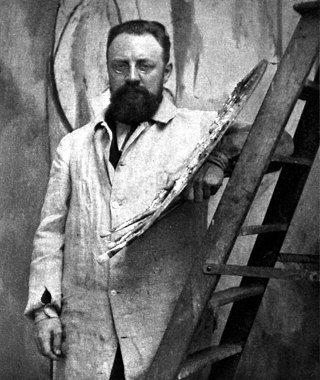
Henri Émile Benoît Matisse was a French visual artist, known for both his use of colour and his fluid and original draughtsmanship. He was a draughtsman, printmaker, and sculptor, but is known primarily as a painter.

Chaïm Soutine was a French painter of Belarusian-Jewish origin of the School of Paris, who made a major contribution to the Expressionist movement while living and working in Paris.

Marc Chagall was a Russian-French artist. An early modernist, he was associated with the École de Paris as well as several major artistic styles and created works in a wide range of artistic formats, including painting, drawings, book illustrations, stained glass, stage sets, ceramics, tapestries and fine art prints.
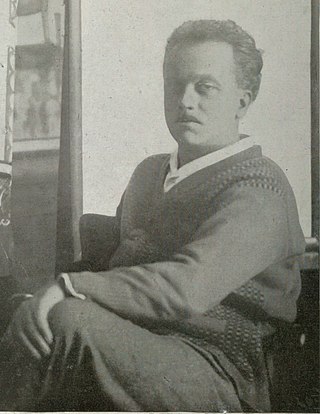
Raoul Dufy was a French painter associated with the Fauvist movement. He gained recognition for his vibrant and decorative style, which became popular in various forms, such as textile designs, and public building decorations. Dufy is most remembered for his artwork depicting outdoor social gatherings. In addition to painting, he was skilled in various other fields, including drawing, printmaking, book illustration, scenic design, furniture design, and planning public spaces.

Léon Joseph Florentin Bonnat was a French painter, Grand Officer of the Légion d'honneur, art collector and professor at the Ecole des Beaux Arts.

Maurice Denis was a French painter, decorative artist, and writer. An important figure in the transitional period between impressionism and modern art, he is associated with Les Nabis, symbolism, and later neo-classicism. His theories contributed to the foundations of cubism, fauvism, and abstract art. Following the First World War, he founded the Ateliers d'Art Sacré, decorated the interiors of churches, and worked for a revival of religious art.

French art consists of the visual and plastic arts originating from the geographical area of France. Modern France was the main centre for the European art of the Upper Paleolithic, then left many megalithic monuments, and in the Iron Age many of the most impressive finds of early Celtic art. The Gallo-Roman period left a distinctive provincial style of sculpture, and the region around the modern Franco-German border led the empire in the mass production of finely decorated Ancient Roman pottery, which was exported to Italy and elsewhere on a large scale. With Merovingian art the story of French styles as a distinct and influential element in the wider development of the art of Christian Europe begins.

Ambroise Vollard was a French art dealer who is regarded as one of the most important dealers in French contemporary art at the beginning of the twentieth century. He is credited with being a major supporter and champion of the contemporary artists of his period, providing exposure and emotional support to numerous then-unknown artists, including Paul Cézanne, Aristide Maillol, Pierre-Auguste Renoir, Louis Valtat, Pablo Picasso, André Derain, Georges Rouault, Paul Gauguin, and Vincent van Gogh.
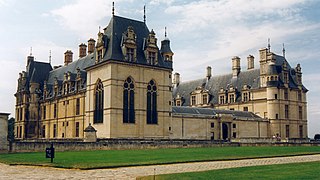
The Château d'Écouen is an historic château in the commune of Écouen, some 20 km north of Paris, France, and a notable example of French Renaissance architecture. Since 1975, it has housed the collections of the Musée national de la Renaissance.

The Matisse Museum is a museum in Le Cateau-Cambrésis, France that primarily displays paintings by Henri Matisse. The museum was established by Matisse himself on 8 November 1952; he also defined the way his works should be arranged. At that time the museum was located in the wedding room of the Le Cateau City Hall.

Henry Lerolle was a French painter, art collector and patron, born in Paris. He studied at Académie Suisse and in the studio of Louis Lamothe.

The Musée d'Art et d'Histoire du Judaïsme or mahJ is the largest French museum of Jewish art and history. It is located in the Hôtel de Saint-Aignan in the Marais district in Paris.
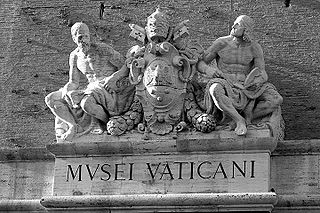
The Collection of Modern and Contemporary Art is a collection of paintings, graphic art and sculptures in the Vatican Museums.

The Marc Chagall Museum is a museum dedicated to the painter Marc Chagall, in his hometown of Vitebsk, Belarus. The museum was founded by the Vitebsk City Executive Committee's decision on October 23, 1991.

Yvette Cauquil-Prince was a Belgian-born weaver and master craftswoman who created tapestries in direct collaboration with renowned 20th-century artists and/or their estates. She is best known for her association with the artist Marc Chagall, which resulted in over 40 tapestries, but she also created tapestries of art works by Pablo Picasso, Max Ernst, Roberto Matta, Paul Klee, Fernand Léger, Pierre Wemaëre, Wassily Kandinsky, Brassai, Alexander Calder, Niki de Saint Phalle, and others.

The Musée Matisse in Nice is a municipal museum devoted to the work of French painter Henri Matisse. It gathers one of the world's largest collections of his works, tracing his artistic beginnings and his evolution through his last works. The museum, which opened in 1963, is located in the Villa des Arènes, a seventeenth-century villa in the neighborhood of Cimiez.

The MACM, the Mougins Museum of Classical Art, private museum inaugurated in June 2011 in the village of Mougins in the Alpes-Maritimes department, France has closed its doors in August 2023 to make way for a new museum, FAMM opening in June 2024.
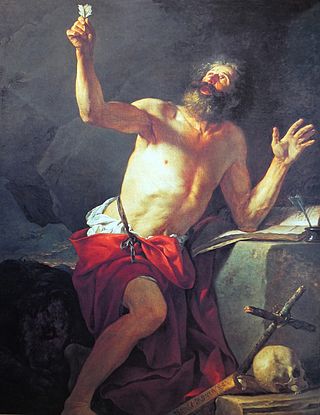
Saint Jerome Hears the Trumpet of the Last Judgment is a 1779 painting by the French artist Jacques-Louis David.

Le Grand Cirque is an oil and gouache on canvas painting by Belarusian-French artist Marc Chagall created in 1956.

Le Grand Cirque is a 1968 oil on canvas painting by Belarusian-French artist Marc Chagall.





















